Cecelia Jane Reynolds and the Cataract House
Underground Railroad history comes alive in this story of Cecelia Jane Reynolds and the Cataract House in Niagara Falls.
As a border crossing, Niagara Falls has a long and fascinating history of Underground Railroad activism. The story of Cecelia Jane Reynolds and the Cataract House showcases some of the daring and heroic feats of enslaved people and their allies.
When Cecelia was six years old, she saw her father taken away in chains. Charles Thruston of Louisville, Kentucky, had sold Mr. Reynolds because he no longer needed him for his rope-manufacturing company.
Three years later, Charles ‘gifted’ Cecelia to his twelve-year-old daughter Frances Ann Thruston. “The two girls had grown up together, […] but from then on, Reynolds would have addressed her former playmate as Miss Fanny, and Thruston's duties would have included training Reynolds and sometimes punishing her.”
In 1846, the Thruston family visited Niagara Falls and stayed at the Cataract House. Cecelia, now fifteen years old, accompanied Fanny as her lady’s maid.
For wealthy white families like the Thrustons, the Cataract House was known for its grandeur and proximity to the Falls. For free and enslaved African Americans, however, it was known as one of the final stops on the Underground Railroad.
The Cataract House employed a large staff of African Americans, many of whom had likely escaped slavery in the South. The waiters were known to help freedom seekers cross the border into Canada. Headwaiter John Morrison even ferried them across the Niagara River himself.
Somehow, Cecelia knew all this too. A year prior, she started to hatch a plan with Underground Railroad operators in Kentucky. Benjamin Pollard Holmes, a steamboat waiter, arranged her escape. In the dead of night, he helped her flee the hotel and get to Morrison’s waiting boat.
While Charles Thruston wanted to send a fugitive hunter after Cecelia, his daughter Fanny quietly sent her money and clothes via the Underground Railroad.
In time, Cecelia and Benjamin married and “settled in Toronto’s bustling black community.” Cecelia learned how to write and began a twenty-year correspondence with Fanny. In part, she wanted to free her mother and younger brother from the Thrustons. Cecelia must have been brokenhearted when Fanny wrote that she could purchase them for $600.
In her later years, Cecelia moved back to Louisville, reconnected with Fanny, and found employment in the household of one of Fanny’s friends. Cecelia was twice widowed and had had three children—all of whom died in childhood.
Cecelia died in Kentucky in 1909. The Cataract House was demolished in 1946. In Heritage Park on Buffalo Avenue, a historic marker designates the site of the former hotel and honors brave freedom seekers like Cecelia Jane Reynolds and the workers who helped them on their journeys.
Hope L. Russell, Ph.D.


